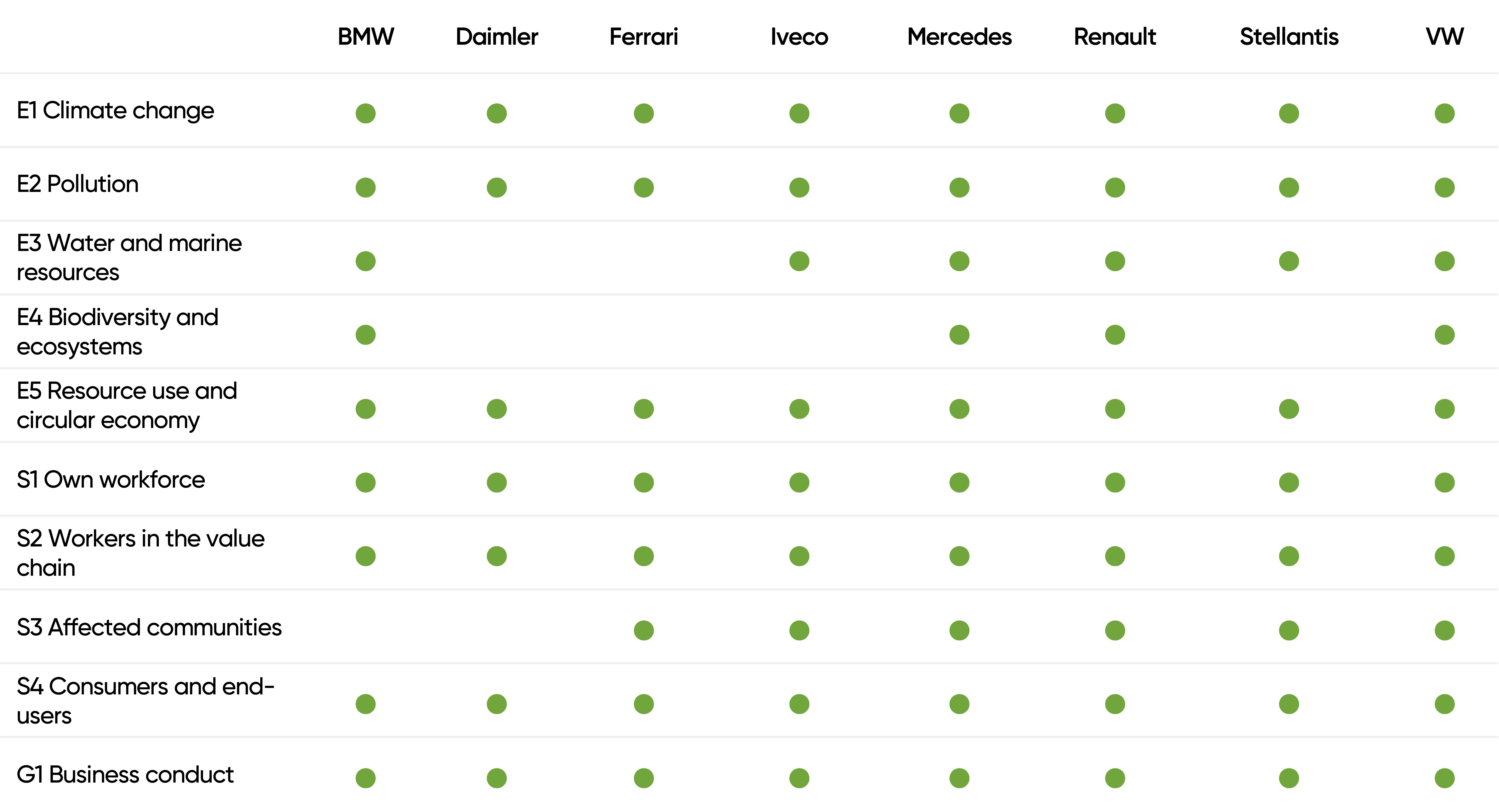How the automotive industry is approaching double materiality under CSRD
Europe’s automotive industry is under pressure. Tariffs, competition from China, the electric revolution, and pressure to cut greenhouse gas emissions are squeezing car and truck makers alike.
As the EU’s Corporate Sustainability Reporting Directive (CSRD) takes effect, it is possible to see how these companies are defining which environmental, social and governance (ESG) issues matter most to their business and stakeholders – and what this reveals about their priorities. This evaluation, or double materiality assessment (DMA), is the starting point for sustainability disclosures under CSRD.
The automotive industry is important to the EU. 7% of the region’s labour force works in vehicle manufacturing and related sectors. The industry accounts for about 7.5% of the economy. The transport sector – chiefly road transport – is also responsible for one quarter of EU emissions and has barely cut these over the past two decades.
At the end of May 2025, ten automotive companies had issued Sustainability Statements under CSRD. We compared the approach to materiality at eight of them: BMW, Daimler Truck, Ferrari, Iveco, Mercedes-Benz, Renault, Stellantis and Volkswagen (VW).
A complex assessment
Companies reporting under CSRD must evaluate ten sustainability topics, 37 sub-topics and 73 sub-subtopics to determine which are material. These are listed in Application Requirement 16 (AR 16) of the CSRD’s accompanying European Sustainability Reporting Standards 1 (ESRS 1).
Given the broad similarity of automotive business models – turning raw materials into vehicles, mostly with internal combustion engines – the companies analysed generally identify and report on similar sustainability issues. Seven of the ten main topics listed in ESRS 1 are deemed material by every company (see table).

The biggest divergence is on biodiversity. Among those who do not consider it material, both Ferrari and Iveco only assessed the impacts of their own plants, however, whereas Daimler and Stellantis also considered the impacts of raw material extraction and vehicle use.
The companies with the highest number of material impacts relating to biodiversity – Mercedes, Renault and VW – all used ENCORE, an online tool that helps companies assess their exposure to nature-related risk. They cite impacts in their supply chain, such as pollution and resource use, but also in the use phase of their products, mainly emissions.
For its part, BMW, concluded that its only material impact on biodiversity was through the extraction of raw materials.
Devil in the detail
The example of biodiversity shows how different approaches to the topic can affect the outcome. But a comparison of how automotive companies evaluate what matters most to their stakeholders or business is complicated by differences in terminology.
While they all stick to the ESRS 1 terms for the main topics, this is not always the case in discussions of sub-topics or sub-sub-topics.
Stellantis, for example, does not say that ‘management of relationships with suppliers including payment practices’ is a material sub-topic under G1 Business conduct. But one can glean this information by reading its impacts, risks and opportunities (IROs) that list ‘late payments’, ‘supplier disruption’, and ‘strategic alliances with suppliers’.
It is at this granular level that some of the most surprising outcomes of the automotive companies’ materiality assessments are visible.
According to EU institutions, road transport accounts for the largest share (37%) of EU nitrogen oxide emissions, linked to 49,000 premature deaths annually in the region. It is also the third-largest emitter (9%) of fine particulate matter, held responsible for 238,000 deaths per year.
Nevertheless, BMW, Ferrari and Mercedes do not consider the air pollution caused by their vehicles to be relevant to their stakeholders or business, though Ferrari adds that it has not consulted affected communities on the issue.
Entity-specific topics
ESRS 1 also allows companies to define material topics other than the 120 provided. Few of those we looked at use this freedom. Renault cites fair transition, the positive impact achieved by retraining workers whose jobs are threatened by the transition to electric vehicles. VW considers corporate citizenship – in the form of environmental, educational and social initiatives at its sites – to be material.
Mercedes, however, has the most entity-specific material topics. It considers its impact on end users to be material in two areas – traffic safety and customer in focus, a commitment to putting customers first – but not in the categories listed in ESRS 1 (information-related impacts, personal safety or social inclusion of users). Mercedes also defines compliance with laws and regulations as material.
The limits of comparability
Under CSRD, companies and their stakeholders determine what ESG topics are most relevant to them, within the guidelines provided. From a bird’s eye perspective, automotive companies have comparable assessments, reflecting similar business models. But the detail of each company’s outcome is determined by how they interpret the guidelines, what methodologies they use and the terminology they employ.
Get comfortable, there’s more
If you enjoyed this article, there's plenty more media to get your mind into.
Sign up to our newsletter
and we'll report back to you with industry news and updates you'll actually want to know.





